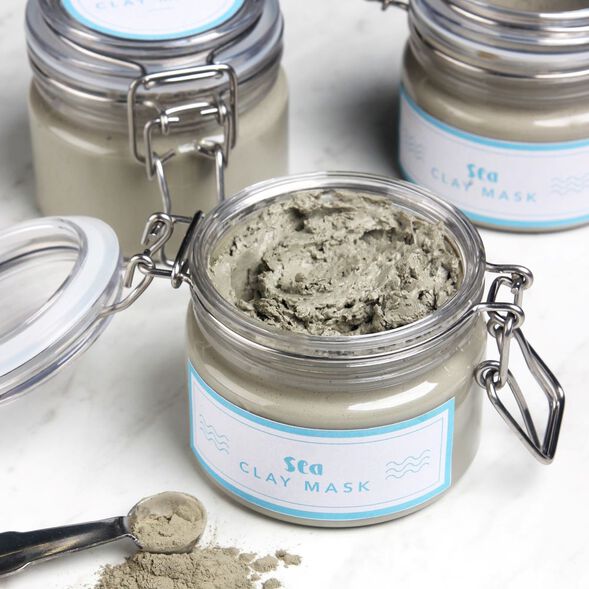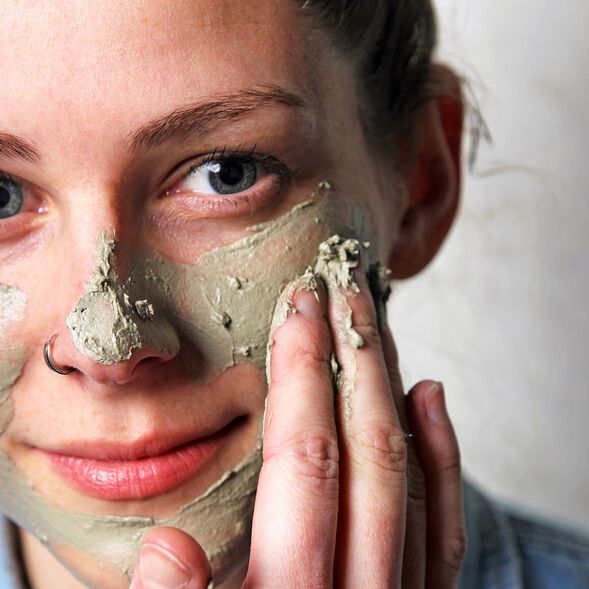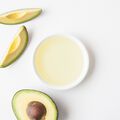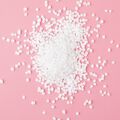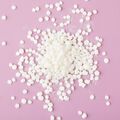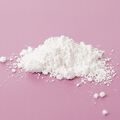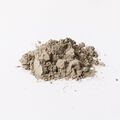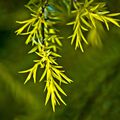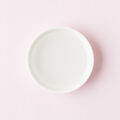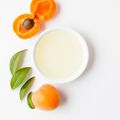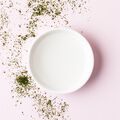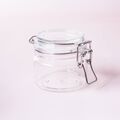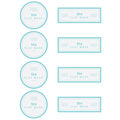
Sea Clay Face Mask Project
- Skill Level: Beginner
- Time: 30 minutes
- Yield: Four 8 oz Jars
Project Description
Sea clay is a classic ingredient for face masks. It originates from mud laid under the sea millions of years ago and has a grayish-green color. Sea clay also has great absorption properties. This mask is specifically formulated for oily skin with a combination of kaolin clay and sea clay. Tea tree essential oil gives it a fresh scent.
This recipe has a thick texture that dries on the skin after about 10-15 minutes, giving you that classic clay mask feeling - you know the one! If you’d like to tweak this recipe for more normal or combination skin, you can decrease the amount of sea clay to 1-2 ounces.
If you have extremely sensitive skin, tea tree essential oil sitting on the skin for 10-15 minutes could be a little irritating. If you’re concerned, you can omit it completely from the recipe. You can also switch out the extract for another if you prefer.
Need more DIY skincare project ideas?
You will need:
- Four Short 8 oz. Bail Jars
- 21.4 oz. Distilled Water
- 1 oz. Apricot Kernel Oil
- 1.3 oz. Avocado Oil
- 1 oz. Polawax Emulsifying Wax
- 0.8 oz. BTMS-50 Conditioning Emulsifier
- 4 oz. Kaolin Clay
- 4 oz. Sea Clay
- 2 mL Tea Tree Essential Oil
- 0.5 oz. Seaweed Extract
- 0.2 oz Optiphen
EQUIPMENT PREP: Disinfect your utensils by dipping them in a 5% bleach water solution and allowing to dry. This includes mixing containers, your stick blender, and any spoons or spatulas that may come in contact with your mask. Your products must be as free of germs, bacteria, and microbes as possible.
CLAY PREP: In a small container, add 4 ounces of kaolin clay and 4 ounces of sea clay.
Follow these steps:
1
In a heat-safe container, combine 1.3 ounces of avocado oil, 1 ounce of apricot kernel oil, 0.8 ounces of BTMS-50, and 1 ounce of Polawax. Heat the container in the microwave using 30-60 second bursts until the waxes melt. Be careful when removing the container, as it will be quite hot. Set aside.
2
In a separate large container, heat 21.4 ounces of distilled water in the microwave (or on the stove top) until it reaches about 160-170° F. If any water evaporates, add more until you have 21.4 ounces.
3
Check the temperatures of both containers. They should be about 160-180° F. Reheat the containers if necessary. Place the stick blender into the water and tap it on the bottom of the bowl to help get rid of bubbles. Pour the oil and wax mixture into the water and use a spatula to make sure every little bit is added. Begin pulsing the stick blender. The mixture will take on a milky appearance once the water, oil, and waxes begin to emulsify. Continue to pulse and stir for about a minute.
4
Add heaping spoonfuls of the kaolin clay and sea clay and pulsing the stick blender until combined.
5
Continue stick blending for about 1-2 minutes. Use a spatula to scrape down any clay that may be on the sides of the bowl. Check the temperature of the mixture. When it's around 130-140° F, add 0.2 ounces of Optiphen, 2 mL of tea tree essential oil, and 0.5 ounces of seaweed extract.
6
Stick blend for 2-3 minutes to ensure everything is fully incorporated.
7
Pour the mixture into the bail jars. If you find you have a lot of bubbles on the top, you can spritz the top of the containers with 99% isopropyl alcohol to help get rid of some of them. Allow the containers to cool for several hours with the lid open to prevent condensation. Once fully cooled, the mixture will be a thick, lotion-like texture.
Tutorial credits
Photographer: Amanda Kerzman

Sea Clay Face Mask Project
- Skill Level: Beginner
- Time: 30 minutes
- Yield: Four 8 oz Jars
Project Description
Sea clay is a classic ingredient for face masks. It originates from mud laid under the sea millions of years ago and has a grayish-green color. Sea clay also has great absorption properties. This mask is specifically formulated for oily skin with a combination of kaolin clay and sea clay. Tea tree essential oil gives it a fresh scent.
This recipe has a thick texture that dries on the skin after about 10-15 minutes, giving you that classic clay mask feeling - you know the one! If you’d like to tweak this recipe for more normal or combination skin, you can decrease the amount of sea clay to 1-2 ounces.
If you have extremely sensitive skin, tea tree essential oil sitting on the skin for 10-15 minutes could be a little irritating. If you’re concerned, you can omit it completely from the recipe. You can also switch out the extract for another if you prefer.
Need more DIY skincare project ideas?
You will need:
- Four Short 8 oz. Bail Jars
- 21.4 oz. Distilled Water
- 1 oz. Apricot Kernel Oil
- 1.3 oz. Avocado Oil
- 1 oz. Polawax Emulsifying Wax
- 0.8 oz. BTMS-50 Conditioning Emulsifier
- 4 oz. Kaolin Clay
- 4 oz. Sea Clay
- 2 mL Tea Tree Essential Oil
- 0.5 oz. Seaweed Extract
- 0.2 oz Optiphen
EQUIPMENT PREP: Disinfect your utensils by dipping them in a 5% bleach water solution and allowing to dry. This includes mixing containers, your stick blender, and any spoons or spatulas that may come in contact with your mask. Your products must be as free of germs, bacteria, and microbes as possible.
CLAY PREP: In a small container, add 4 ounces of kaolin clay and 4 ounces of sea clay.
Follow these steps:
1
In a heat-safe container, combine 1.3 ounces of avocado oil, 1 ounce of apricot kernel oil, 0.8 ounces of BTMS-50, and 1 ounce of Polawax. Heat the container in the microwave using 30-60 second bursts until the waxes melt. Be careful when removing the container, as it will be quite hot. Set aside.
2
In a separate large container, heat 21.4 ounces of distilled water in the microwave (or on the stove top) until it reaches about 160-170° F. If any water evaporates, add more until you have 21.4 ounces.
3
Check the temperatures of both containers. They should be about 160-180° F. Reheat the containers if necessary. Place the stick blender into the water and tap it on the bottom of the bowl to help get rid of bubbles. Pour the oil and wax mixture into the water and use a spatula to make sure every little bit is added. Begin pulsing the stick blender. The mixture will take on a milky appearance once the water, oil, and waxes begin to emulsify. Continue to pulse and stir for about a minute.
4
Add heaping spoonfuls of the kaolin clay and sea clay and pulsing the stick blender until combined.
5
Continue stick blending for about 1-2 minutes. Use a spatula to scrape down any clay that may be on the sides of the bowl. Check the temperature of the mixture. When it's around 130-140° F, add 0.2 ounces of Optiphen, 2 mL of tea tree essential oil, and 0.5 ounces of seaweed extract.
6
Stick blend for 2-3 minutes to ensure everything is fully incorporated.
7
Pour the mixture into the bail jars. If you find you have a lot of bubbles on the top, you can spritz the top of the containers with 99% isopropyl alcohol to help get rid of some of them. Allow the containers to cool for several hours with the lid open to prevent condensation. Once fully cooled, the mixture will be a thick, lotion-like texture.
Tutorial credits
Photographer: Amanda Kerzman
You will need:
- Four Short 8 oz. Bail Jars
- 21.4 oz. Distilled Water
- 1 oz. Apricot Kernel Oil
- 1.3 oz. Avocado Oil
- 1 oz. Polawax Emulsifying Wax
- 0.8 oz. BTMS-50 Conditioning Emulsifier
- 4 oz. Kaolin Clay
- 4 oz. Sea Clay
- 2 mL Tea Tree Essential Oil
- 0.5 oz. Seaweed Extract
- 0.2 oz Optiphen
EQUIPMENT PREP: Disinfect your utensils by dipping them in a 5% bleach water solution and allowing to dry. This includes mixing containers, your stick blender, and any spoons or spatulas that may come in contact with your mask. Your products must be as free of germs, bacteria, and microbes as possible.
CLAY PREP: In a small container, add 4 ounces of kaolin clay and 4 ounces of sea clay.
Follow these steps:
1
In a heat-safe container, combine 1.3 ounces of avocado oil, 1 ounce of apricot kernel oil, 0.8 ounces of BTMS-50, and 1 ounce of Polawax. Heat the container in the microwave using 30-60 second bursts until the waxes melt. Be careful when removing the container, as it will be quite hot. Set aside.
2
In a separate large container, heat 21.4 ounces of distilled water in the microwave (or on the stove top) until it reaches about 160-170° F. If any water evaporates, add more until you have 21.4 ounces.
3
Check the temperatures of both containers. They should be about 160-180° F. Reheat the containers if necessary. Place the stick blender into the water and tap it on the bottom of the bowl to help get rid of bubbles. Pour the oil and wax mixture into the water and use a spatula to make sure every little bit is added. Begin pulsing the stick blender. The mixture will take on a milky appearance once the water, oil, and waxes begin to emulsify. Continue to pulse and stir for about a minute.
4
Add heaping spoonfuls of the kaolin clay and sea clay and pulsing the stick blender until combined.
5
Continue stick blending for about 1-2 minutes. Use a spatula to scrape down any clay that may be on the sides of the bowl. Check the temperature of the mixture. When it's around 130-140° F, add 0.2 ounces of Optiphen, 2 mL of tea tree essential oil, and 0.5 ounces of seaweed extract.
6
Stick blend for 2-3 minutes to ensure everything is fully incorporated.
7
Pour the mixture into the bail jars. If you find you have a lot of bubbles on the top, you can spritz the top of the containers with 99% isopropyl alcohol to help get rid of some of them. Allow the containers to cool for several hours with the lid open to prevent condensation. Once fully cooled, the mixture will be a thick, lotion-like texture.
Tutorial credits
Photographer: Amanda Kerzman


